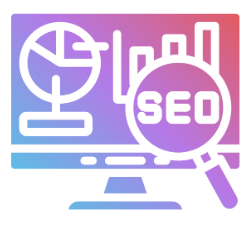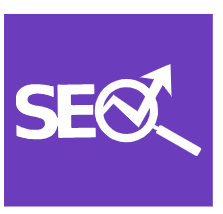Unlock the potential of SEO and SEM.
Search Engine Optimization(SEO).

In the ever-expanding realm of digital marketing, SEO and SEM stand as twin pillars, shaping the online visibility and success of businesses. SEO, the organic counterpart, involves optimizing web content to improve search engine rankings, drawing in quality traffic through unpaid efforts. On the other hand, SEM encompasses paid strategies, leveraging tools like Google Ads to place businesses at the forefront of search engine results, ensuring immediate visibility.
Together, they form a dynamic duo, propelling brands to new heights in the competitive digital landscape. In this exploration, we unravel the intricacies of SEO and SEM, revealing their distinct roles and collaborative potential in driving online success.
Where the online presence of businesses is frequently the first point of contact with implicit guests. Search Machine Optimization (SEO) emerges as a critical strategy for enhancing visibility, driving organic business, and eventually fostering business growth. In this composition, we will unravel the complications of SEO, slipping light on its significance for businesses and furnishing perceptivity into casting a successful SEO strategy.
Difference between SEO and SEM.

Definition of SEO and SEM:
- SEO (Search Engine Optimization): Focuses on optimizing web content to improve organic (unpaid) search engine rankings.
- SEM (Search Engine Marketing): Involves paid advertising strategies to enhance a website’s visibility in search engine results.
Nature of SEO and SEM:
- SEO: Primarily organic and takes time to show results.
- SEM: Involves paid methods for immediate visibility and results.
Components of SEO and SEM:
- SEO: Involves on-page optimization, content creation, backlink building, and technical improvements.
- SEM: Includes pay-per-click (PPC) advertising, Google Ads, and other paid search marketing techniques.
Cost of SEO and SEM:
- SEO: Generally long-term and cost-effective but requires ongoing efforts.
- SEM: Immediate results but involves advertising costs that can vary based on bidding and competition.
Traffic Source of SEO and SEM:
- SEO: Drives organic traffic from search engine results.
- SEM: Drives paid traffic through advertisements.
Results Tracking of SEO and SEM:
- SEO: Performance tracked through organic search rankings and website analytics.
- SEM: Performance measured through ad metrics like click-through rates (CTR) and conversion rates.
Flexibility of SEO and SEM:
- SEO: Takes time to adapt to changes in search engine algorithms.
- SEM: Allows for quick adjustments in ad campaigns for optimal results.
Longevity of SEO and SEM:
- SEO: Long-term strategy with sustained benefits.
- SEM: Yields immediate results but stops when advertising budget is exhausted.
The substance of SEO for Business.

- Visibility and Credibility – In a world where hunt machines serve as the gateway to the internet, businesses cannot go to remain unnoticeable. SEO ensures that your business isn’t just present online but is prominently featured when druggies search for applicable products or services. The advanced your website ranks in hunt machine results, the further believable and secure it appears to implicit guests.
- Driving Targeted Business– Unlike traditional marketing styles that cast a wide net, SEO allows businesses to target specific cult laboriously searching for their products or services. By optimizing for applicable keywords, businesses can attract druggies who are more likely to convert into guests, performing in a advanced return on investment (ROI).
- Cost- Effectiveness – SEO stands out as a cost-effective marketing strategy compared to paid advertising. While paid styles can yield quick results, they come at a price. SEO, on the other hand, requires an outspoken investment but can give sustainable, long- term benefits. Once your website achieves a solid ranking, the ongoing costs are fairly minimum compared to paid advertising.
Key Components of an Effective SEO Strategy:
1.Keyword Research and Optimization – 
launch by conducting thorough keyword exploration to identify the terms and expressions your target followership is likely to use when searching for products or services. – Integrate these keywords strategically into your website’s content, meta markers, and headlines to gesture applicability to search machines.
 2. Quality Content Creation –
2. Quality Content Creation –
Content is the backbone of SEO. Craft engaging, instructional, and applicable content that addresses the requirements and enterprises of your target followership. Regularly modernize your website with fresh content, demonstrating to hunt machines that your point is active and furnishing value.
3. On- runner Optimization –
Optimize on- runner rudiments similar as title markers, meta descriptions, and title markers to give clear signals to search machines about the content on each runner ensure that your website is stoner-friendly, with easy navigation and a mobile- responsive design, contributing to a positive stoner experience.
 4. Link structure Strategies –
4. Link structure Strategies –
figure a robust backlink profile by acquiring high- quality, applicable links from authoritative websites in your assiduity. -Internal linking within your website helps search machines understand the scale and connections between different runners, enhancing overall SEO.
5.Original SEO for Brick- and- Mortar Businesses – 
For businesses with physical locales, optimizing for original hunt is pivotal. Claim and optimize your Google My Business table, encourage client reviews, and insure accurate business information across online directories.
Measuring Success and nonstop enhancement of SEO and SEM.
- Analytics and Monitoring
Use tools like Google Analytics to track crucial criteria similar as website business, and conversion rates. – Regularly cover your SEO performance, identify trends, and acclimate your strategy consequently.
- Rigidity and Updates
The geography of SEO is dynamic, with hunt machine algorithms constantly evolving. Stay informed about assiduity trends, algorithm updates, and stylish practices to acclimatize your strategy consequently. –
- Regular Updates
Regularly update and refresh your content to insure its applicability and alignment with evolving hunt intent. Conclusion In the competitive digital business, SEO is not just a marketing strategy; it’s a abecedarian element of a business’s online success.
- Well investment
By investing in a well drafted SEO strategy, businesses can enhance visibility, attract targeted business, and establish a strong foundation for sustained growth. As the digital geography continues to evolve, embracing and learning the principles of SEO remains a strategic imperative for businesses aiming to thrive in the online ecosystem.
Search Engine Marketing (SEM): Fueling Business Growth in the Digital Frontier
In the fast-paced world of digital marketing, Search Engine Marketing (SEM) emerges as a powerful tool for businesses seeking rapid online visibility and increased reach. SEM involves leveraging paid advertising to secure prime real estate on search engine results pages (SERPs), providing an immediate and targeted way to connect with potential customers.
-
Immediate Visibility:
One of the key advantages of SEM is its ability to deliver instant visibility. Through platforms like Google Ads, businesses can bid on specific keywords related to their products or services. When users enter these keywords into a search engine, the business’s ads can appear prominently, ensuring immediate exposure to a relevant audience. This immediacy is particularly beneficial for promotional campaigns, product launches, or time-sensitive offers.
-
Targeted Advertising:
SEM allows businesses to fine-tune their targeting, ensuring that their ads reach the most relevant audience. Advertisers can customize their campaigns based on factors such as location, demographics, interests, and search intent. This precision targeting ensures that marketing budgets are spent efficiently, reaching those who are more likely to convert into customers.
-
Measurable ROI:
One of the standout features of SEM is its measurability. Unlike traditional forms of advertising where ROI can be challenging to gauge, SEM provides robust analytics and reporting tools. Businesses can track key performance indicators (KPIs) such as click-through rates, conversion rates, and overall campaign success. This data-driven approach allows for continuous optimization, ensuring that resources are allocated to strategies that deliver the best results.
-
Flexibility and Control:
SEM offers unparalleled flexibility and control over advertising campaigns. Advertisers can adjust bids, budgets, and targeting parameters in real-time, responding swiftly to changes in market conditions or business objectives. This adaptability enables businesses to stay agile in the dynamic digital landscape, refining their approach to maximize impact.
-
Enhanced Brand Visibility:
Apart from driving immediate results, SEM contributes significantly to overall brand visibility. Even if users don’t click on the ad, the repeated exposure to a brand through search results builds familiarity and trust. This brand reinforcement can influence user perceptions and decisions when they are ready to make a purchase.
Conclusion for SEO and SEM:
In the digital age, where competition for online visibility is fierce. SEO and SEM has its own importance and role. SEM stands as a formidable ally for businesses aiming to stand out. By combining strategic paid advertising with SEO efforts, businesses can create a holistic digital marketing approach that maximizes their reach and impact. SEM is not just a marketing tool; it’s a dynamic force. That accelerates business growth in the ever-evolving landscape of the digital frontier.

